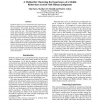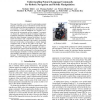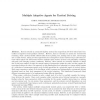42 search results - page 8 / 9 » Reacting, Planning, and Learning in an Autonomous Agent |
AAAI
2000
13 years 8 months ago
2000
If robotic agents are to act autonomously they must have the ability to construct and reason about models of their physical environment. For example, planning to achieve goals req...
AAAI
2011
12 years 7 months ago
2011
This paper describes a new model for understanding natural language commands given to autonomous systems that perform navigation and mobile manipulation in semi-structured environ...
APIN
1998
13 years 7 months ago
1998
Abstract. Recent research in automated highway systems has ranged from low-level vision-based controllers to high-level route-guidance software. However, there is currently no syst...
ECAI
2006
Springer
13 years 11 months ago
2006
Springer
This work presents some anticipatory mechanisms in an agent architecture, modeling affective behaviours as effects of surprise. Through experiment discussion, the advantages of bec...
AAAI
1996
13 years 8 months ago
1996
Research on mobile robot navigation has produced two major paradigms for mapping indoorenvironments: grid-based and topological. While grid-based methods produce accurate metric m...



